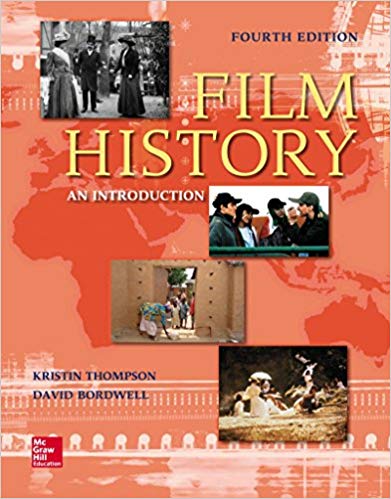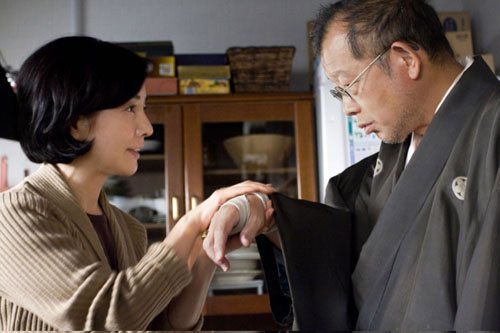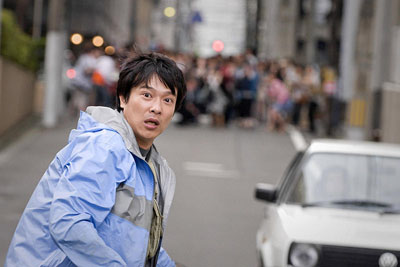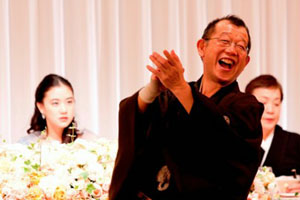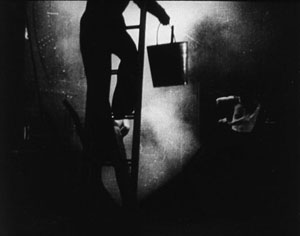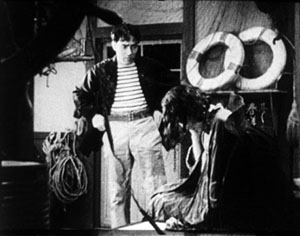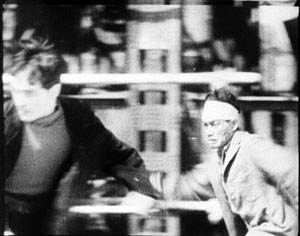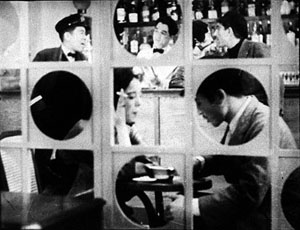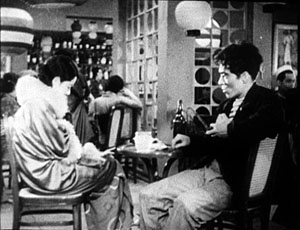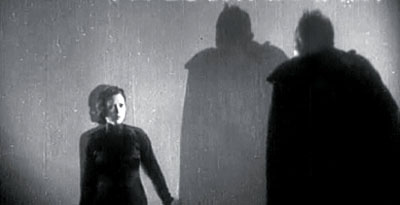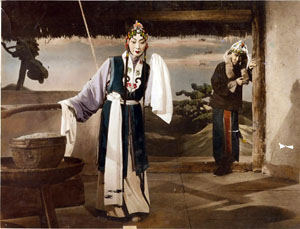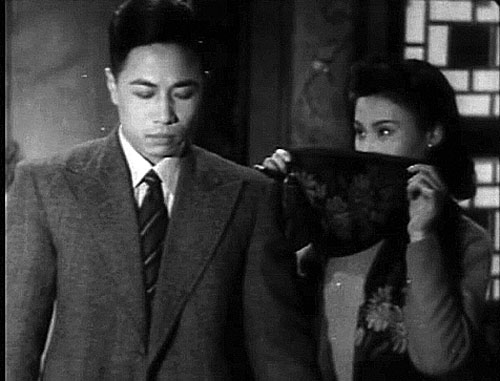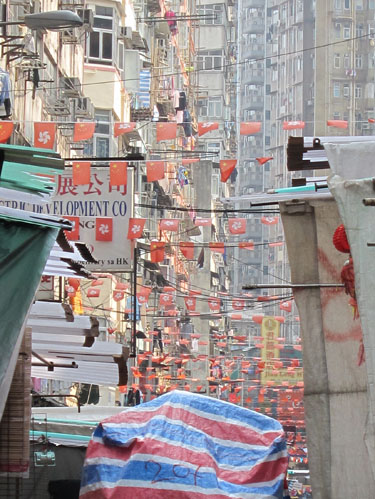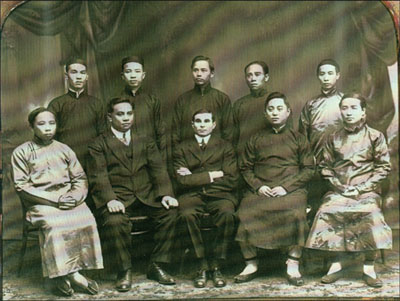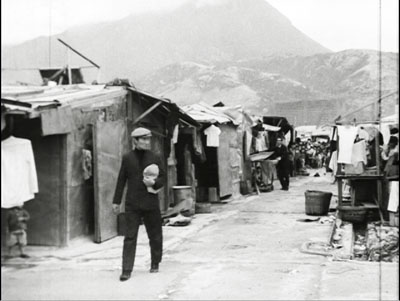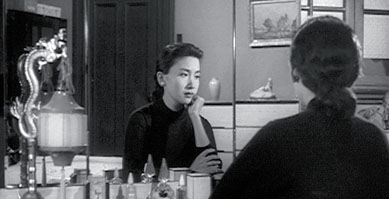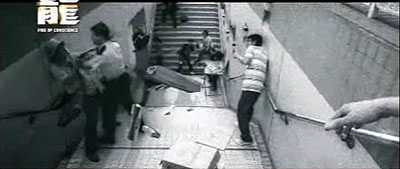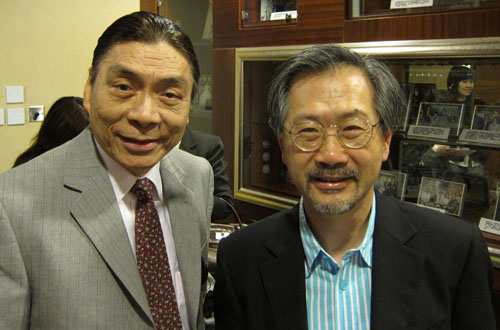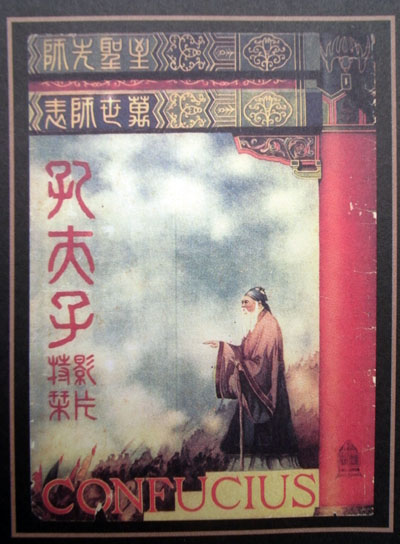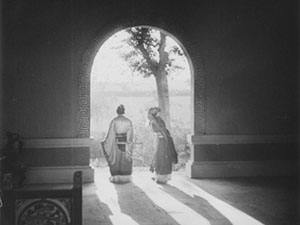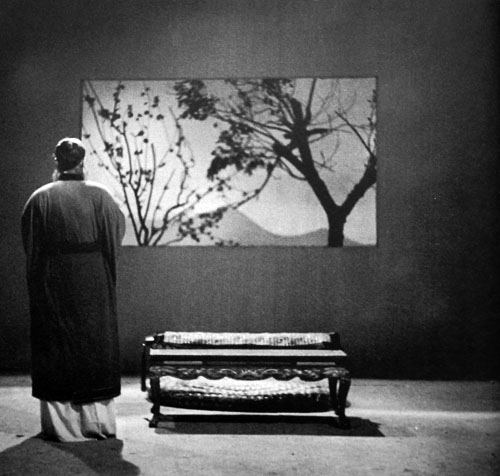Archive for the 'Directors: Fei Mu' Category
The Omnivoyeur’s dilemma
Otouto.
DB here:
Any major film festival is really many festivals. You meet someone who tells you about all the films they’ve been seeing, and the overlap with your dance card is virtually nil. You’ve both been in the same town, and probably hit the same venues, but you’ve been to different festivals.
Then there are certain syndromes. You convince yourself you need to see 3-5 films a day. Otherwise, what’s the point of traveling all this way? Soon you realize, horribly, that after a couple of days of this regimen, you can’t recall what you’ve seen. Some early afternoon, Festival Amnesia will set in, and you can’t remember what you saw that morning. Was it that ambitious but ultimately unsatisfying little romance from the Bosporus? Or the Chinese movie about moping teenagers trying to leave their dingy village? What were the names of those movies, anyhow?
My own symptoms are getting acute. Twice in recent years, I have found myself in front of a film suddenly realizing that I had seen it at another festival. I had forgotten the title. At least I caught my mistake with the first shots, but I expect that in time I will obliviously sit through the whole movie twice—probably liking it on the first pass and declaring it disappointing on the second.
Then there’s Viewer’s Remorse. Watching 3-5 titles a day, you inevitably encounter some stinkers. You take this philosophically until you meet someone else, who rhapsodizes about the string of masterpieces they’ve seen. Suddenly you realize that you have backed losers. Your friend has had a transformative festival experience, and you might as well have been flossing. Worse, your carefully picked mediocrities swell in your mind, blotting out the good films you managed to catch by dumb luck. Panicked, you thumb through the schedule to see if the great things you’ve missed are playing a second time.
They aren’t.
So film festivals aren’t by any means the sweet deal they may at first seem. Even putting aside queueing, officious door staff, racing between venues, and projection problems, there are plenty of features to make people like me more neurotic than we already are.
But I can’t complain about my latest visit to Hong Kong. True, breathing problems put me out of commission some days and eventually forced me to return home early. My biggest regrets were missing the Zanussi films and the two Angelopolous films, The Weeping Meadow and The Dust of Time. (Watch: Somebody will tell me they are all masterpieces.) Still, I managed to see a fair amount in two mini-festivals I carved out of Filmart and the festival proper.
Turning Japanese, yet again
Golden Slumber.
Parade, from director Isao Yukisada, is an ensemble picture about Tokyo twentysomethings sharing a flat. Their love affairs and marathon viewings of soap operas are disrupted when Satoru, a male prostitute, crashes there one night and winds up hanging around with them. With his blank passivity and ambisexual good looks he arouses their curiosity and, as usual in such movies, winds up changing everyone’s lives. The film was pretty good at portraying the way the kids keep life intriguing by conjuring up mysteries about their neighbors. (Is the man next door running a brothel?) The plot ran out of steam, I thought, but I enjoyed seeing a movie in that sober style that apparently only the Japanese can now pull off: only about 400 shots in nearly two hours, with an unassertive fixed camera that gave the characters room to breathe.
Also about a young cohort, but more action-driven, was Golden Slumber, by Nakamura Yoshihiro. He directed Fish Story (2008), a favorite of mine from last year’s festival. This one is about a hapless young man pulled into a plot to assassinate the prime minister. Threaded with glimpses of his college days, when he and his pals worked in a fireworks shop and became connoisseurs of fast food, the plot follows his efforts to avoid arrest and find how he was framed. Like a lot of contemporary Asian films, Golden Slumber sounds a note of nostalgia not only for long-lost innocence but also for kids’ self-consciously retro tastes in popular culture—in this case, the Beatles song “Golden Slumbers” (“Once there was a way to get back home . . . .”). Less zany than Fish Story, whose story pivoted around how an obscure album prepared for the end of the world, this seemed to me finally quite agreeable, thanks to its likably awkward hero and its lovelorn ending.
Longtime readers of this blog won’t be surprised that one favorite of my personal Japanese mini-fest was Yamada Yoji’s tear-jerker Otouto (aka Ototo, “Younger Brother”), a remake of a 1960 Ichikawa film. A widow who ekes out a living as a pharmacist is about to marry off her beautiful daughter. But during the wedding dinner her ne’er-do-well brother pops up and turns the ceremony into a catastrophe. Japanese movies are very good at evoking social embarrassment, and the disruption caused by Tetsuro makes you wriggle in your seat. He could have been simply a lovable loser, but he’s not that likable, let alone lovable, and his waywardness brings misfortunes on his sister’s family. In this movie about how you must love your relations no matter what, Yamada shows the classic resignation to family ties that has characterized the films from the Shochiku studio since the 1920s.
As usual with Yamada, the direction is crystalline in a way you hardly ever see now: calm framings, unhurried pacing, longish takes (about 12 seconds on average), and lighting and composition that etch every object in relief. When Ginko the mother peels an apple, the skin curls off in a long ribbon, and it’s as fascinating as a car chase in any other movie. In a film in which the camera seldom moves, a handheld shot regains some of its original power. Maybe I’m what Groucho called a sentimental old fluff, but like Kabei–Our Mother, Otouto shows that some cinematic traditions are still worth something.
For the real Shochiku flavor, experts will tell you, you need to return to the 1930s, and the festival did so with its small retrospective of Shimazu Yasujiro. A prolific director of comedies and dramas (he made over a hundred silent films), Shimazu built a reputation in the 1920s with family dramas like Father (1923). Most of his films are lost, and he died in 1945, so he didn’t benefit from the postwar revival of the industry and its growing renown in the West. His most famous work is probably the ingratiating Our Neighbor Mis Yae (1934), which features in the retrospective.
The remaining Shimazu films don’t seem to me to reveal the stylistic consistency we find in Ozu or Mizoguchi or Shimizu. There are flamboyant pictorial touches in First Steps Ashore (1932), a drama of sailors and prostitutes with stark lighting and cluttered sets influenced by The Docks of New York.
A fight scene is rendered in a long-lens shot that looks very modern, though the technique had already been seen in Japanese swordplay films.
Perhaps most original are the variants Shimazu works on a picturesque divider in a waterfront bar, which becomes a fascinating grid that sorts out faces.
Having been trained by this cheese-grater divider, we are given the tougher task of spotting the seaman peering from the distance at our stoker hero and the taxi dancer he rescues. (Not so easy to see in my still: He’s watching from the square and circle aligned horizontally behind the hero’s lips and chin.)
This “game of vision,” where we must strain to see action that’s blocked by bits of setting or furnishing, is characteristic of Japanese film then and since.
Okoto and Sasuke (1935) and Lights of Asakusa (1937), the two Shimazus I caught during my stay, aren’t as visually tricky as First Steps Ashore, but they display Shimazu’s characteristic interest in marginal characters (a blind woman in Okoto, stage performers in Asakusa). Both films close with a self-sacrificing retreat from the world. Later films, including the wonderful Brother and His Younger Sister (1939), would give this retreat a positive ideological spin. Disgusted by office politics, a young man takes his sister and mother to Manchuria to start anew, and the finale shows a clump of earth clinging to the plane wheels, as if a bit of Japan’s very soil would sanctify the empire’s new outpost.
Fei Mu, Film Poet
Nightmares in Spring Chamber.
A second mini-festival during my Hong Kong stay centered on Chinese film history. I’ve mentioned the Patrick Lung Kong titles in an earlier entry. The other prime figure was Fei Mu, celebrated as one of China’s best filmmakers. His Spring in a Small Town (1948) is often considered the greatest of all Chinese films, and it’s not an unreasonable judgment.
Unfortunately, only about half of Fei’s output survives. The earliest film we have is Song of China (aka Filial Piety, 1935), a paean to Confucian virtues. Parents permit their son to move to the city, but the son falls prey to self-indulgence and a temperamental wife. Even when he holds a banquet to honor his parents it is merely an excuse for what the father calls “revelry and gambling.” Soon the daughter is being seduced by a city slicker and told that “parental consent is a timeworn tradition.” This lesson in traditional morality is filmed quite fluently, with telling use of tracking shots, especially during the banquet, and sudden bursts of angular montage.
On Stage and Backstage (1937), from a Fei Mu script, is a 37-minute comedy. A troublesome diva refuses to come to a performance unless she’s paid, but the manager can’t afford it. So a street performer is brought in to substitute for the star in a performance of Farewell My Concubine. While the production is shot frontally and with little depth, director Zhou Yihua contrasts that area of action with the backstage milieu by means of layered compositions and lateral tracking shots through tangles of ropes and props. I enjoyed this charming film when I saw it during my first trip to Hong Kong, and its appeal held up well for me.
I came home too soon to catch Bloodshed on Wolf Mountain (1936), usually considered a strong work, and the little-seen Children of the World (1940). Other films in the series included The Show Must Go on (1952) from a Fei script and Romance in the Boudoir (1960), from Fei’s brother Louis; I already discussed the latter here. There were also two Chinese Opera films. A Wedding in the Dream (1948), China’s first color film, stars the legendary Mei Lanfang, the Peking Opera performer best known in the west who became friends with Chaplin and Eisenstein.
This image from Wedding in the Dream is a posed production still; the film itself, a straightforward record of Mei’s performance, survives in dreadfully worn condition. I found Murder in the Oratory (1937) more intriguing. A man is urged by his mother to murder his wife, the daughter of the man who killed his father. From the start, when an opera stage dissolves into a fully three-dimensional space, you realize that this will be an experiment in creating something halfway between canned theatre and a “filmic” treatment. So we get all the trappings of an opera performance, including stylized movement and singing, but with the camera weaving among the characters and furnishings, finding unusual angles, and even assuming characters’ optical viewpoints.
Far different is another title I enjoyed on my first visit to Hong Kong in 1995. Nightmares in Spring Chamber (1937) is an episode in the portmanteau film Lianhua Symphony. This 13-minute allegory of Japan’s imperial ambitions shows a maniacal frock-coated Japanese pursuing innocent Chinese girls through a vast bare villa. He cackles over a spinning globe and captures one girl, but she’s rescued by the other, a surrogate for the Chinese soldier we glimpse occasionally. Full of canted angles, hallucinatory visions, under lighting, looming shadows, and other trappings of German Expressionism, and accompanied by snatches of Debussy and the Danse macabre, it’s a far cry from the other items in the series, and it suggests a director of considerable versatility.
Last year the Festival premiered the restoration of the rerelease of Fei’s 1940 Confucius, which I wrote about then. This year a second restoration inserted titles to cover the gaps and put some scrappy scenes into their proper order. In addition, a very informative book, Fei Mu’s Confucius, accompanied the screenings. The essays explicate the film from several angles, including its relation to Confucian doctrine, to classic poetry and painting, and to other Fei Mu works.
Thanks to retrospectives like this one, we can see how much Fei’s official masterwork owes to his earlier efforts. There are touches of lighting and staging in these films that are more subtly developed in Spring in a Small Town, and the stately pacing of Confucius is here put to more mundane subject matter. Still, nothing I saw matches the quiet erotic boldness of this milestone of world cinema, which anticipates so much of what we find in Antonioni and other postwar European filmmakers.
So much to see, and even less time than I’d planned: Film festivals somehow manage to leave you unsatisfied and yet feeling full. A nice dilemma to have.
Spring in a Small Town.
Hopscotching through history
Temple Street, Hong Kong.
DB here:
Thanks to the Film Festival and screenings at the Film Archive, I’ve skipped gratefully through nearly a hundred years of local film history.
The Roast Duck legend, cooked at last?
First things, or rather first films, first. Last year local authorities declared 2009 to be the centenary of Hong Kong cinema. The long-standing claim (repeated in my Planet Hong Kong) was that To Steal a Roast Duck, aka The Trip of the Roast Duck, was made in 1909 and was the first locally produced fiction film. The controversy arose because the claim was based on later recollections of filmmakers. No fiction films from that era survived. We had no contemporary evidence that the Roast Duck was made in that year or that it was the first anything. Perhaps it wasn’t even made at all? In a blog entry last year, I summed up the arguments.
Now, thanks to the persistence of Frank Bren and Law Kar, we can come to more reliable conclusions. At a conference in December, scholars from around the world gathered at the Hong Kong Film Archive to discuss early Chinese cinema. One of the results was further revelations about the territory’s first film.
We know that at some point the Ukrainian-American entrepreneur Benjamin Brodsky came to Hong Kong and set up a film unit. (The picture above shows him surrounded by nine Chinese co-directors of the company he founded in November 1914.) An earlier Brodsky company made Roast Duck, among other films. But when?
At the conference Law Kar announced the discovery of a 1914 Moving Picture World interview with Roland Van Velzer, a photographer recruited from New York by Brodsky. During his stay in what he called “that queer land” of Hong Kong, Van Velzer shot four films in 1914.
We did a first native drama, entitled “The Defamation of Choung Chow.” With my experience and guidance the picture turned out well and when shown in public proved to be a wonderful drawing card. . . . The reason of its great popularity was because it was a Chinese piece entirely. . . . We made three other subjects during my stay there. These were: “The Haunted Pot,” The Sanpan Man’s Dream” and “The Trip of the Roast Duck,” the latter a rough “chase” picture. All of these pictures had phenomenal runs at the native theaters.
According to Van Velzer, then, the first film, made and shown in 1914, was what is now known as Chuang Tzi Tests His Wife. Roast Duck was evidently the fourth film made by the team that year.
Brodsky is significant not merely because he supported talent in producing the colony’s first fictional films. He also made long documentaries about China and Japan that played in the US. He seems to have been a colorful guy. In his barnstorming circus days, he once purged a lion with castor oil. Full details are here in an article by Bren and Kar. In the meantime, we can look forward to a more plausible centenary of Hong Kong film in 2014.
Social conscience, modern stylings
The Story of a Discharged Prisoner.
Hop ahead to the 1960s. Although the local language of Hong Kong is Cantonese, movies in Mandarin rule the market, with Shaw Brothers providing gaudily colored costume pictures, musicals, romantic dramas and comedies, and of course rather violent swordplay exercises. By contrast films made by Cantonese companies under tiny budgets look threadbare. Yet a few filmmakers tried to make Cantonese cinema more vigorous and innovative, and the most influential was Patrick Lung Kong.
Lung Kong was born in 1935, and by the time he was thirty he had performed in virtually every production role, from screenwriting and producing to publicity and distribution. Well-known as an actor since 1958, he graduated to directing in1966 with Prince of Broadcasters. His second film, The Story of a Discharged Prisoner (1967) was a landmark in local cinema, expressing sympathy for an ex-convict who tries to avoid being pulled back into crime. Lung Kong goes on to make many of the socially critical films of the period: Teddy Girls (1969), Hiroshima 28 (1974), and Mitra (1976). He ceased directing in 1981 but continued to work as an actor and distributor. He now lives in New York City, but he came back for the retrospective that the Film Archive has mounted.
I had seen some Lung Kong films in earlier visits to Hong Kong, but the retrospective will allow us to assess his career as a whole. Virtually none of his films are available on DVD, and none, as far as I know, with English subtitles. Particularly important, apart from the works I’ve mentioned, are his heavily censored film about a plague striking Hong Kong, Yesterday Today Tomorrow (1970) and the bitter domestic drama Pei Shih (1972).
When he started in the industry, he says, “I ran into these acquaintances who taunted me by saying how I was trying my hand at making Cantonese chaan pin [shabby films]. That was very insulting to the film profession in general…so I promised myself to go in and change things when the opportunity arose.” For him, change meant both modernizing Cantonese film technique and tackling social problems.
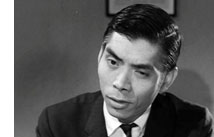 Lung Kong’s cinema, all agree, has a strong moralizing bent. He focuses on social problems—juvenile delinquency, nuclear war, prostitution, the exploitation of women in marriage. The films mix sensationalism, partly as audience bait, and social criticism. The Story of a Discharged Prisoner, reimagined by Tsui Hark and John Woo as A Better Tomorrow (1986), is at once a gangster tale and a harsh comment on the poverty that drives men to crime. Lung himself, armed with calisthenic eyebrows, plays the police officer hounding the protagonist. The Prince of Broadcasters begins as a pointed critique of popular culture, where schoolgirls fasten obsessively on a playboy radio personality. The film devolves into a more traditional thwarted-lovers plot when the protagonist reforms through his (mostly) chaste relationship with a wealthy girl.
Lung Kong’s cinema, all agree, has a strong moralizing bent. He focuses on social problems—juvenile delinquency, nuclear war, prostitution, the exploitation of women in marriage. The films mix sensationalism, partly as audience bait, and social criticism. The Story of a Discharged Prisoner, reimagined by Tsui Hark and John Woo as A Better Tomorrow (1986), is at once a gangster tale and a harsh comment on the poverty that drives men to crime. Lung himself, armed with calisthenic eyebrows, plays the police officer hounding the protagonist. The Prince of Broadcasters begins as a pointed critique of popular culture, where schoolgirls fasten obsessively on a playboy radio personality. The film devolves into a more traditional thwarted-lovers plot when the protagonist reforms through his (mostly) chaste relationship with a wealthy girl.
Lung’s film style is self-consciously 1960s modern, with zooms, calculated compositions, and handheld passages. He cuts fast, avoids dissolves, and offers fairly complex traveling shots. Looking at the cheap sets and listening to the awkward sound (including snippets of classical music and The Great Escape grabbed from LPs), one becomes aware of what a Cantonese director of the day was up against. So if the technique seems at times forced, you can at least admire Lung’s attempt to give his films a contemporary gloss.
The films were of crucial importance for local culture of the 1960s and have had continuing influence on younger directors. A very informative book of essays and interviews, produced to the usual handsome standards of the Film Archive, is in Chinese but includes a disk with a digital pdf of English translations. Two of the texts can be found here.
Jean Christophe in Macau
Another hop. I know nothing about Louis Fei, except that he was the brother of Fei Mu, whom I’ll be talking about in an upcoming entry. Romance in the Boudoir (1960) recasts the core situation of Fei Mu’s masterpiece Spring in a Small Town (1948). The situation, drawn from Romain Rolland’s novel Jean Christophe, is simple: A woman in a loveless marriage is visited by her former lover. In this version, her husband is a miserly doctor who wants the lover, Qin, to help him get a hospital post. Qin’s presence in the household rekindles the old romance and the couple hover on the edge of adultery.
Romance in the Boudoir is a bold piece of work. It opens with a prologue showing husband and wife trudging through Macau, utterly distant from each other. On the soundtrack we hear a woman singing about marriage as a prison. When Qin arrives, a parallel sequence traces him from the harbor to the household as a male vocalist sings of his weariness and broken heart. These melodic soliloquies will be evoked later in the film, when Qin and Suxuan stretch out by the fireplace and start to sing as the camera circles them.
Louis Fei makes maximal use of the house set, letting the vast staircase dominate the action on both floors. Repeated setups from the top of the stairs show the bannister cutting diagonally into the frame, pointing like an arrow to the climactic moment at the front door in the distance. Over everything hovers erotic tension, lasting several minutes during one scene when the former lovers tentatively touch one another before recoiling and then drawing toward one another again. If the doctor is somewhat caricatural, the portrayals of the wife and lover show a great subtlety, and the use of props, notably a glass of milk, is nicely modulated. This film shows how comparative large budgets enabled the Mandarin-language companies to make films of a high production standard, both in script and execution.
Dragons on fire
Now jump to 2010. Dante Lam is the hot new action director on the local scene, after the success of Beast Stalker (2008) and The Sniper (2009). Actually, like most overnight successes, he’s been at it awhile. He made an admirer of me with Jiang Hu: The Triad Zone (2000), which has one of the most graceful passages of graphic cutting (involving a red umbrella) that I’ve seen in recent Hong Kong film.
He’s back with the first big action film of the season, tagged with the barely adequate English title Fire of Conscience. The action scenes are better than the plot, which is better than the eternal impassivity of Leon Lai, a pictorial cipher in nearly every role he assumes. Still, you have to reckon with a film that includes not only a thrilling car chase, a truly scary gunfight in a restaurant, and grenades tossed around pretty casually but also a pregnant woman locked in a car slowly filling with carbon monoxide. The topper comes in the very last few shots, which provide as gruesome a flashback image as I’ve seen in quite some time and justifies the key line, “Save for revenge, what else is there?”
Visually, Fire of Conscience never surpasses the bravado of the black-and-white CGI opening, during which the camera coasts through a snapshot of action and lets clues float and scatter around the frozen characters. (It’s admittedly gimmicky, but more hypnotic than the comparable Watchmen opening.) Still, it’s exciting genre fare. What hath Ben Brodsky wrought?
Photo of Brodsky and colleagues by courtesy of Mr. Ronald Borden. The interview with R. F. Van Velzer was published in Hugh Hoffman, “Film Conditions in China,” Moving Picture World (25 July 1914), 577. Thanks to Frank Bren and Law Kar for this information, and to Tony Slide for calling attention to the article. The quotation from Lung Kong is from Clarence Tsui, “Scenes of the Crime,” South China Morning Post (22 March 2010), C1.
Patrick Lung Kong, with Sam Ho of the Hong Kong Film Archive.
Confucius reborn
DB, in Hong Kong:
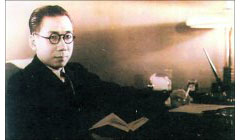 Fei Mu is a little-known name in the West, but on the evidence of even a few films, it’s clear that this mainland Chinese filmmaker was one of the finest working anywhere during the 1930s and 1940s. His best-known film, Spring in a Small Town (1948), was considered in the Maoist era an overliterary piece of sympathy for the bourgeoisie. Now things have changed. Many specialists today consider Spring in a Small Town the best Chinese film of all time. It’s an extraordinary work, anticipating Antonioni in its slow unfolding of an erotic situation, treated with a mixture of sympathy and austerity. It’s a great pity that the film isn’t available on good and subtitled DVD copies, though a digitally restored print was made in 2005.
Fei Mu is a little-known name in the West, but on the evidence of even a few films, it’s clear that this mainland Chinese filmmaker was one of the finest working anywhere during the 1930s and 1940s. His best-known film, Spring in a Small Town (1948), was considered in the Maoist era an overliterary piece of sympathy for the bourgeoisie. Now things have changed. Many specialists today consider Spring in a Small Town the best Chinese film of all time. It’s an extraordinary work, anticipating Antonioni in its slow unfolding of an erotic situation, treated with a mixture of sympathy and austerity. It’s a great pity that the film isn’t available on good and subtitled DVD copies, though a digitally restored print was made in 2005.
Two other Fei Mu films I’ve seen show the variety and flexibility of his craft. Onstage, Backstage (1936) is a drama of theatre life, and its fluid figure movement in depth recalls Renoir. Very different is the expressionistic allegory Nightmares in Spring Chamber (1937), an episode in the portmanteau film called Lianhua Symphony. Fei presents the Japanese invasion of China as the pursuit of an innocent girl through dark sets by a leering, frock-coated Japanese. Other surviving Fei works, such as Blood on Wolf Mountain (1936), are also held in high regard. After Mao’s revolution, Fei Mu moved to Hong Kong, where he died at the age of 45. He directed no films in the Crown Colony.
All this makes the discovery of a print of Confucius (1940) an event of capital importance. An anonymous individual donated a print to the Hong Kong Film Archive, which spent years restoring it in collaboration with L’Immagine Ritrovata of Bologna. In the donated print of Confucius, some portions of the soundtrack had liquefied, so some stretches are silent, and there are about nine minutes of fragments that have yet to be integrated.
At the premiere, a very useful booklet on the film’s restoration was given out, and moving introductory speeches were presented by Barbara Fei Ming-yee, the director’s daughter, and Serena Jin, daughter of the producer Jin Xinmin. The screening added electronic subtitles that not only translated the dialogue but identified each speaker—a helpful gesture for a film with many characters and a tangled intrigue.
I can’t comment on it as a representation of Confucius’ thought and life, although experts tell us that it is quite different from the elevated, almost sanctified portrayals that were known before. The plot dramatizes the ineffectuality of the sage’s ideals of civic virtue by showing how power players of his era ignored or undercut his teachings. Scenes from Confucius’ life alternate with scenes of political and military strategy, as warlords and statesmen debate tactics and, not incidentally, calculate how to eliminate Confucius. As Confucius migrates across China, he is unable to halt the continuous warfare among various factions. His disciples leave or die. Just before his death he has only his grandson to care for him. “A great educator, thinker, and philosopher,” Fei Mu writes in an essay, “Confucius was doomed a victim of the politics of his time.”
The film is slow-moving and hieratic. Some of the fragments show bits of violence, but the film as a whole relies on dialogue. Although some scenes unfold in natural exteriors, Fei Mu often employs theatrical tableaus, complete with painted landscapes; occasionally the actors cast shadows on the backdrops. The cutting is often axial, simply enlarging a chunk of space as actors declaim their dialogue. The nearly square Movietone frame enhances the symmetry of the compositions, which often feature a window or some other aperture.
Knowing the fluid style of Fei’s 1930s films, we can only regard this rigid, rather ceremonial look as a deliberate artistic choice. In this respect, the film recalls Eisenstein’s Alexander Nevsky and Mizoguchi’s Genroku Chushingura, films of that era aiming to treat a weighty historical subject with solemnity. In Confucius, Fei seems to have been rethinking the relation of cinema to theatre, a quest that preoccupied other directors of the period and that remains important today. Wong Ain-ling’s essay in the booklet aptly notes Rohmer’s Perceval le Gallois as a more recent parallel, and the film likewise has some of the feel of the Straub/ Huillet version of Von heute auf morgen (1997). As often happens, Fei Mu feels like a modern filmmaker.
Confucius was shown across China in 1940 and 1941, and a reedited version was released in 1948. Fei Mu was so upset by the new cut that he took out a newspaper ad denouncing it. Wong Ain-ling, who prepared the documentation for the festival presentation, and Sam Ho, the Archive Programmer, have concluded that this print is likely to have been the re-release version. Sam told me that the archive staff would be spending the next year researching how to integrate the fragments and supply a sense of the original’s design. The Archive is planning to screen that restoration at next year’s festival. Whatever the experts come up with, surely this is a discovery that will be discussed and enjoyed for many years.











